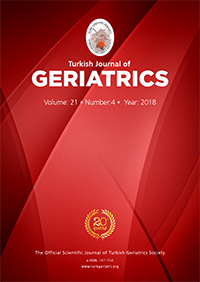2Manisa Celal Bayar University, Faculty of Medicine, Department of Familt Medicine, Manisa, Turkey
3Manisa Provincial Health Directorate, Åehzadeler District Health Directorate, Manisa, Turkey DOI : 10.31086/tjgeri.2018.65 Introduction: The present study aimed to determine the prevalence of depressive symptoms in elderly people living in Manisa and to reveal the possible risk factors.
Materials and Method: The population of this cross-sectional study included 17760 elderly people living in the Manisa Celal Bayar University Health Education and Research District in 2017. The sample size of the study was calculated as 546 using Epi Info 7.0 software. Sample selection was performed by a simple random sampling method of the records of Manisa Provincial Public Health Directorate. The data were collected by authors, and the participation ratio was 97.8% (n=534). The Katz Index of Independence in Activities of Daily Living and Geriatric Depression Scale were used as data collection tools, in addition to a sociodemographic form. The data were analyzed by using descriptive statistics, univariate and multivariate Odds ratios (with logistic regression analysis).
Results: The mean age of the participants was 72.70Âḟ6.35 years. Of note, 56.3% of the elderly participants were women, 44.3% were primary school graduates and 19.6% were living alone. Moreover, 78.6% of them had at least one chronic disease requiring continuous medication. The prevalence of depressive symptoms was 32.8%.

